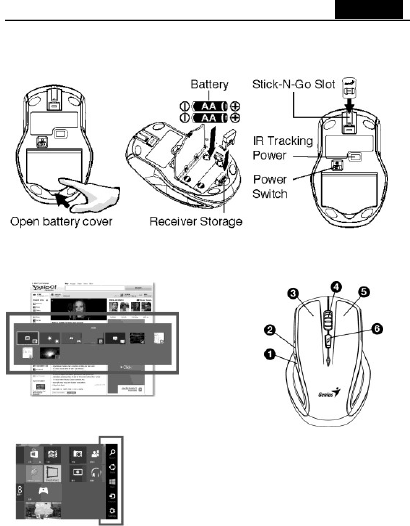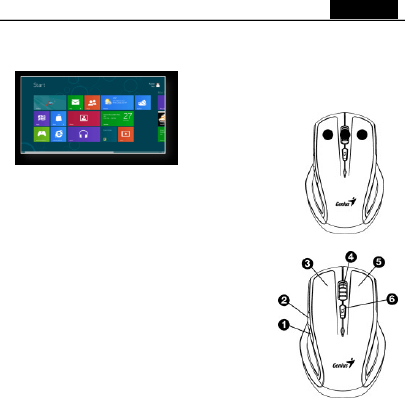KYE SYSTEMS GMZKR Wireless Mouse User Manual Hardware Installation
KYE Systems Corp Wireless Mouse Hardware Installation
Exhibit 08 User Manual

DX-8500 M/N: GM-130006/S English
-1-
Hardware Installation
1. You can connect the receiver to a USB port of a PC.
2. Install two AA batteries in the mouse as instructed.
3. Make sure that you have switched on the power switch underneath the mouse.
Button definitions in Windows 8:
1. Switch between Apps: Pressing the side button 1 allows you to switch between all open
applications.
2. Charms panel: Press side button 2 to open up the
Charms panel.
3. Left Button: Provides traditional mouse functions like click, double click and drag.
4. Magic-Roller: Spin the “Magic-Roller” to surf the Internet, scroll within apps or any
Windows documents.

DX-8500 M/N: GM-130006/S English
-2-
5. Right Button: Provides traditional mouse click functions.
6. When both buttons 1 and 2 are pressed at the same time, it will allow you to toggle
between Windows 8 Metro interface and the last app used.
Note:
When buttons 3, 4 and 5 are pressed at the s ame time, it
will allow you to change between Windows 8 and
traditional mouse function mode.
Button definitions in Windows 7/XP/Vista:
1. Previous Page: Go to last page of Internet Explorer
2. Next Page: Go to next page of Internet Explorer
3. Left Button: Provides traditional mouse functions like
click, double click and drag.
4. Magic-Roller: Press the “Magic-Roller” to surf the
Internet and Windows documents.
5. Right Button: Provides traditional mouse click functions.
6. DPI adjustment: The LED indicates will flash after you
press this button. Default is 1200 dpi, 800 dpi (1 flash),
1200 dpi (2 flashes), and 1600 dpi (3 flashes).
Note: Download the programmable driver from Genius
website at www.geniusnet.com
Warning: (Troubleshooting)
1. Do not use the wireless optical/laser mouse on a desk which is made of glass or mirror.
2. The connection of the wireless device is factory preset, so when you plug the USB
receiver into any USB port, the connection between the micro receiver and the mouse will
be established automatically.
3. In case your PC did not install the hardware successfully, remove the micro receiver from
the USB port and go Human Interface Devices under Device Manager to remove the
mouse then plug in the micro receiver to a USB port again.
4. If you feel the mouse does not move smooth as usual, it is possible the batteries have lost
their charge so you need to replace them. Remember to put the batteries in the correct
direction. Warning: do not mix or use different types of batteries at the same time.

DX-8500 M/N: GM-130006/S English
-3-
FEDERAL COMMUNICATIONS COMMISSION INTERFERENCE
STATEMENT
This equipment has been tested and found to comply with the limits for a Class B
digital device, pursuant to Part 15 of the FCC Rules. These limits are designed to
provide reasonable protection against harmful interference in a residentia l
installation. This equipment generates uses and can radiate radio frequency energy
and, if not installe d and used in accordance with the instructions, ma y cause
harmful interference to radio communications. However, there is no guarantee that
interference will not occur in a particular installation. If this equipment does cause
harmful interference to radio or television reception, which can be determined by
turning the equipment off and on, the user is encouraged to try to correct the
interference by one or more of the following measures:
– Reorient or relocate the receiving antenna.
– Increase the separation between the equipment and receiver.
– Connect the equipment into an outlet on a circuit different from that to which the
receiver is connected.
– Consult the dealer or an experienced radio/TV technician for he lp.
CAUTION:
Any changes or modifications not expressly approved by the party responsible for
compliance could void the user's authority to operate the equipment.
This device complies with part 15 of the FCC Rules. Operation is subject to the
following two conditions: (1) This device may not cause harmful interference, and
(2) this device must accept any interference received, including interference that
may cause undesired operation.